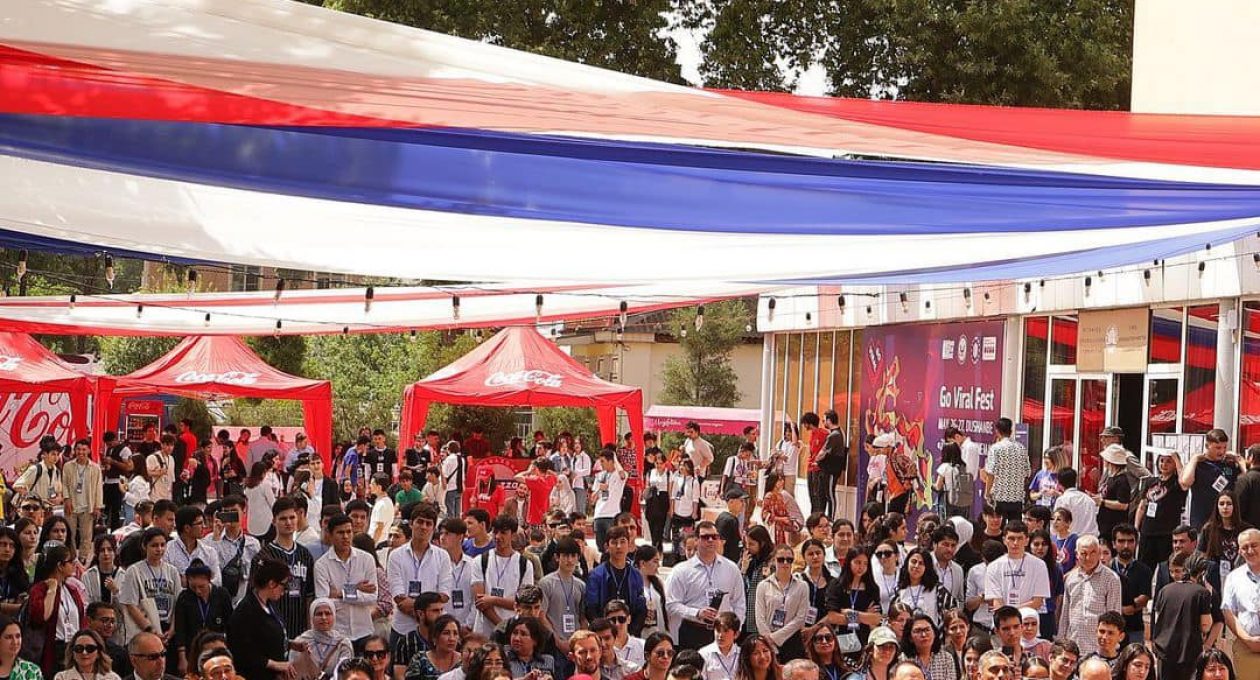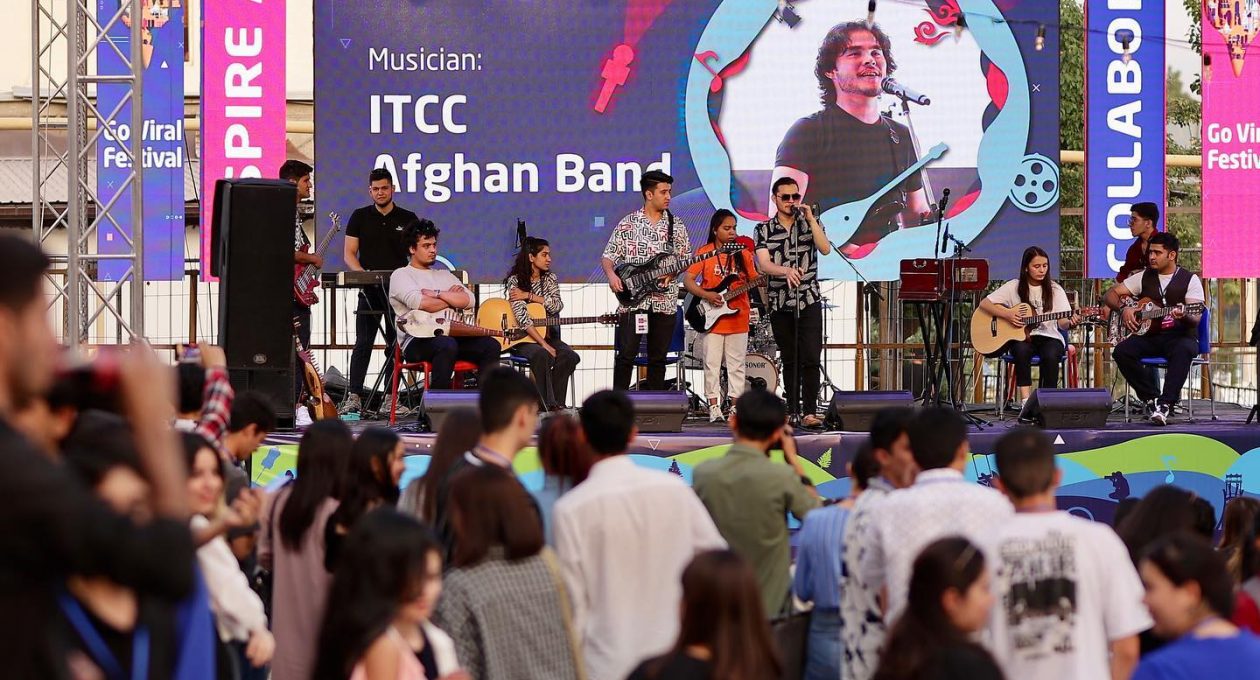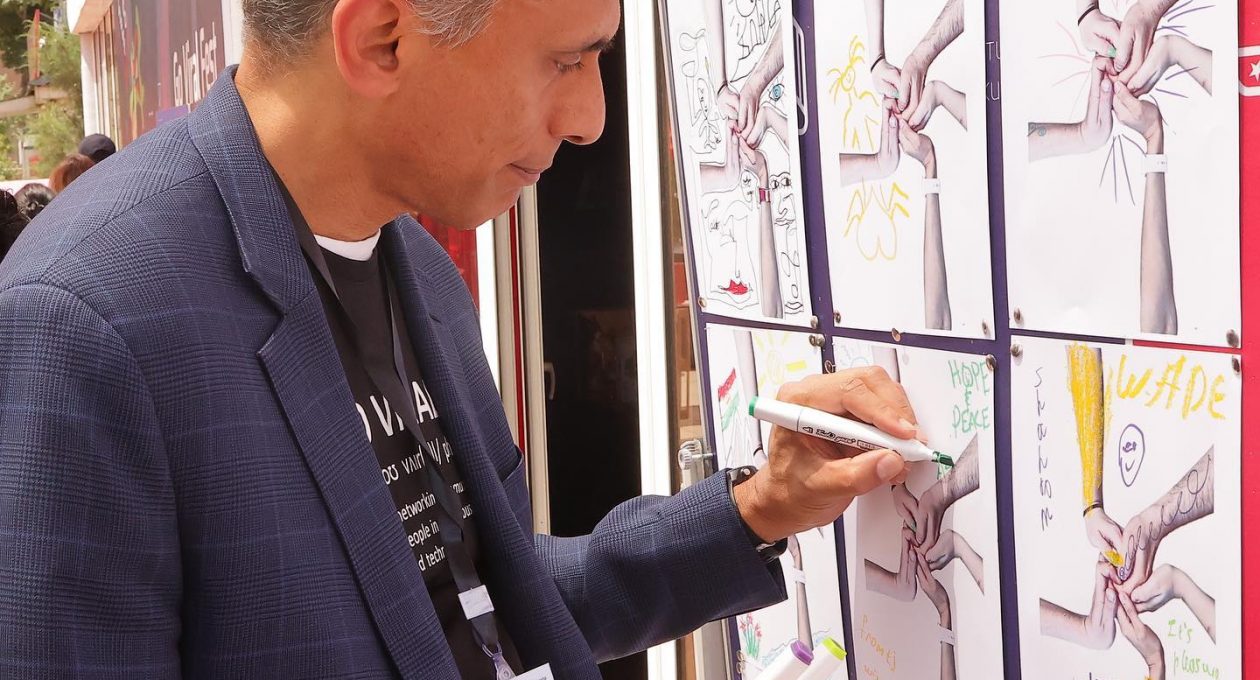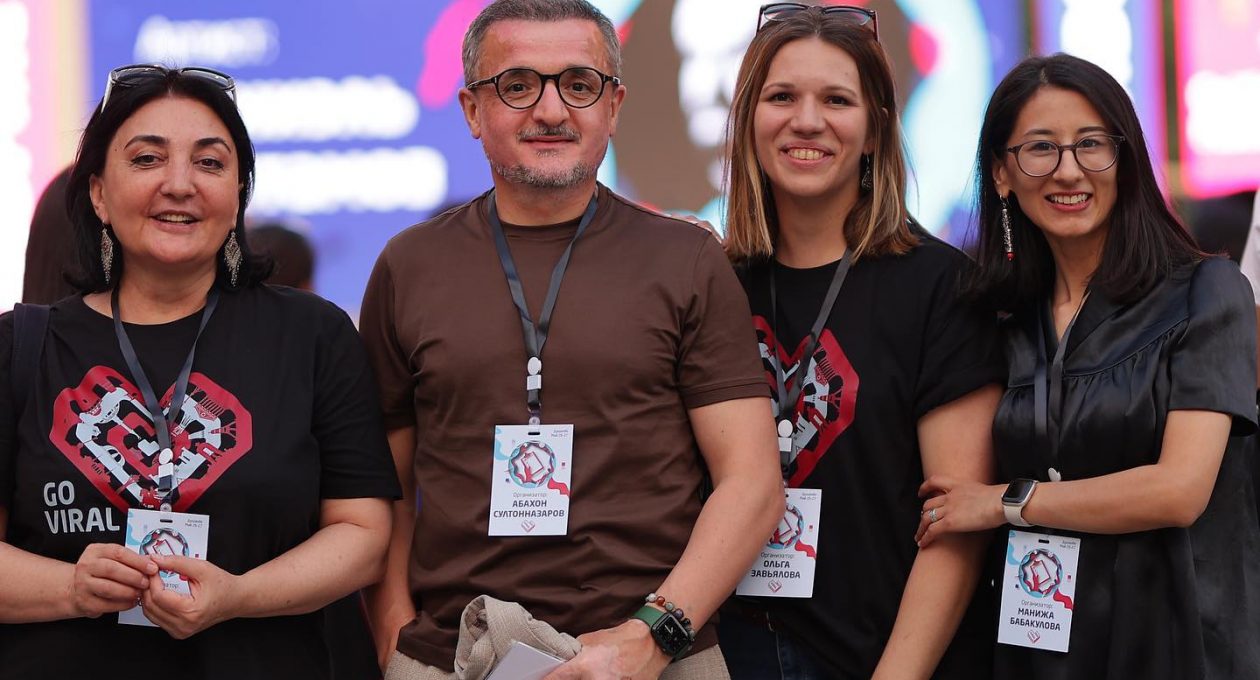More than 600 enthusiasts and experts of all backgrounds, ages and interests gathered at the Zebunniso Cinema in Dushanbe. All these people are united by the annual Go Viral grand festival, which is already a favourite of all Tajiks.

Go Viral festival in Dushanbe brings people together to discuss and find solutions to problems and develop answers to the most pressing issues.
In the beautiful and large courtyard of the Zebunniso Cinema, the festival was opened by Abakhon Sultonazarov, Regional Director of the Institute for War and Peace Reporting (IWPR) in Central Asia, Manuel Micaler, United States Ambassador to Tajikistan, as well as Zach Bazzi, Spirit of America Regional Director.
Welcoming the participants and guests of the festival, Abakhon Sultonazarov, described Go Viral as a regional project that provides a platform for networking and community building across sectors and countries.Sultonazarov recalled that for the second year “IWPR in Central Asia has been given the honour of hosting this grand festival”.
“Go Viral is a regional platform for networking among opinion leaders, innovators and creative people from Central Asia to exchange ideas and help achieve their goals as well as solve problems,” he said.U.S. Ambassador Extraordinary and Plenipotentiary to Tajikistan Manuel Micaller noted in his complimentary salutation that the United States is working with Tajikistan to empower the next generation as “our economies grow together.”
“By implementing innovations together, you are creating an inclusive, exciting and promising future for Tajikistan. We are proud that Tajikistan has one of the strongest Go Viral networks in Central Asia,” said Micaller.
Spirit of America Regional Director and one of the IWPR partners, Zach Bazzi, emphasized that no other event brings together so many different people – entrepreneurs, journalists, innovators, artists, opinion leaders, designers and, in general, dreamers. He followed up his speech by saying that “no event inspires young people to dream big and turn those dreams into reality like Go Viral.”
“We believe that the best way to achieve sustainable positive change is through partnership and dialogue between cultures, languages, and different points of view. After all, the differences in our perspectives are what drive innovation, creativity and problem-solving,” he said.
The IWPR partners for the Go Viral festival are also the Coca-Cola Company, Asia Plus Media Group and telecom operator Babilon-T.
On the first day of the festival, panels were held in various halls of the Zebunniso cinema covering four areas – media, business, IT and culture, where nationally renowned experts and specialists shared the secrets of their professions with young people.
How to use artificial intelligence?
In one of the halls, experts from Tajikistan and Kazakhstan discussed the opportunities, challenges, present and future of creative professions in today’s realities.
According to the speakers, the field of creative professions in the country is rapidly developing and the professions associated with it are becoming more and more in demand. However, it is very important not to ignore the new technologies and challenges in the creative professions but to experiment with one’s work using new opportunities along with keeping one’s mind and creativity open to new ideas.
Discussing new challenges and opportunities in the creative professions, digital illustrator Nasiba Karimova stressed that at the beginning it was difficult for her to move from traditional painting to digital art.
“In traditional painting, I was physically seeing an easel, picking up brushes and applying paints to the canvas, but in digital illustration, all these tools are in one tablet. It feels different,” says Nasiba.
This complexity has become an opportunity for collaboration and mutual help. Nasiba began taking private lessons from Farrukh Safarzade, a graphic designer and illustrator, and in return, she taught him lessons in traditional art drawing.
Speaking about the opportunities and challenges of the creative professions, the speakers highlighted the role of recently emerged artificial intelligence applications, which include the generation of images based on text queries.
“Such software can become an assistant in your creative work, they can do some part of your work, thus saving you time and resources that you can direct to the general strategic vision of your project,” said Davlat Zohidov, a VFX specialist.
“Artificial intelligence is already an inevitability, it is present in different areas of our lives. Either we will ride this wave and be in tune with it, or we will be under this wave and miss a lot of opportunities”, noted Bakhrom Kholmatov, UX/UI designer.
The speakers answered numerous questions from the panel discussion participants and expressed hope that the young people would choose professions involving greater creativity.
Global Activism in the Face of the digital revolution
The next session led by Megan Ward was dedicated to the growing global activism and empowerment amid the digital revolution.
Megan shared her unique experience as founder and CEO of the leading branding agency Femology, which helped her identify some of the societal norms that have resulted in many women not advancing in their careers. She spoke with special enthusiasm about how she started Femology, Detroit’s first women-focused co-working centre.
“Femology is more than just an office space for women. Femology has changed the way businesswomen view themselves and their community by helping to grow their businesses,” said Megan.
The speaker inspiringly stated that Femology’s unique positioning has brought together over 15,000 women from different walks of life and enabled them to access different opportunities as well as fostered intergenerational relationships that were often lacking in the professional environment.
Megan advised young and aspiring entrepreneurs to find their unique angle on a particular problem by paying attention to the skills and opportunities they already have.
Profit is not the main goal of the business!
The session “Care for the Future: How to combine profit and responsibility” began with a discussion of authorship in business, combining profit in one’s business with a contribution to the solution of certain social problems, and social responsibility in business.
Speaking about business, human rights activist Dilrabo Samadova stressed the importance of the social responsibility principle in business.
“We promote freedom in all its terms, including in business,” said Dilrabo Samadova – Executive Director of the Civil Liberties Office, which runs the TUT co-working space.
All experts at today’s panel agreed that profit should not be the main factor in doing business. Speakers highlighted the importance of creating, supporting and promoting values and the community.
“When I opened the café, I, first of all, wanted to create a community that would gather young people from different areas, different subcultures around me,” added Zarrina Gafurova, founder of the Monday co-working café.
“If you want to change the world, start with yourself,” added Iskandar Ikrami, founder of coffee shops in Dushanbe and Tashkent.
The War for Attention: a brief history of content personalisation
Manuchehr Gafforzoda, founder of a start-up in the area of Big Data has stated the importance of personalised advertising. According to him, the main challenge for advertisers is to understand what is happening in each home and what the people who live there want.
In 2000, Google came along and helped to solve this problem. The company uses a search engine to read the information entered, collect it and sell it.
The importance of personalisation has also been understood by giants such as Netflix and Amazon.
In 2006, streaming service Netflix launched a million-dollar contest to create recommendation algorithms. Thanks to these algorithms, the company generated $7.92 billion in revenue in 2022.
Amazon earns $35 billion more each year on similar recommendation algorithms.
“Businesses in Tajikistan, unfortunately, are deprived of such an opportunity. Advertising is not personalised, which prevents the market from growing,” Gafforzoda said.
The dark side of personalised content is people’s addiction to social media and gadgets. YouTube, for example, optimises its feed for the user, which greatly increases the time spent on the platform. More videos of the same topic and complementary topics are added to the primary query videos, essentially dragging them down the rabbit hole.
Making a short film: from an Idea to the Production
Aziz Sattori, a filmmaker and graduate of the Gerasimov Institute of Cinematography, conducted a master class on how to make a short film.
He said that short film dramaturgy consists of film structure, character, conflict, idea and script. The script is the backbone of cinema, he said
“A good screenwriter in modern filmmaking is a diamond,” Sattori said.
He added that the audience itself is the object of cinema and everything it experiences is called the magic of cinema.
“Today, audiences need constant emotional leaps and bounds to keep their attention. People need to experience the entire spectrum of emotions,” Sattori said.
While answering questions, he pointed out that in filmmaking, every one of the people involved in the process plays a crucial role.
During the workshop, participants came up with their ideas for a script based on the condition that the film must involve a person, a camera and inspiration. The first story was about an artist looking for inspiration all over the world. The second was about a boy who was given a worn-out old camera for his birthday. The third was about a homemaker and her dog who died in a car accident.
Media and Blogging in Tajikistan: the past, the Present, the Future
Famous Tajik bloggers and journalists Faridun Zamonov, Nargis Kasymova, Rafael Gulov, Manizha Akhmedova and Habibjon Bahriddinov spoke about media and blogging at the Go Viral.
The session began with the question of what role a diploma plays in the choice of profession. The speakers shared the common view that knowledge, desire, talent and an understanding of what you want are much more important.
“Get fulfilment, do what your heart desires,” said Nargis Kasymova.
Nargis Kasymova recently started blogging.
“Today I realize that my target audience is those who are close to me in spirit. In the future, I hope that the number of my subscribers will continue to grow,” she added.
About trends
Manizha Akhmedova shared that in 2002 when she joined Asia-Plus, colleagues predicted the disappearance of the radio, but surveys show that to this day, the radio has its audience.
“You need to feel the audience in order not to lose it.”
About the content on YouTube and Instagram
“I have different content on Instagram and YouTube because there are two different audiences,” says Rafael. According to him, the YouTube audience is older, with people who are in the mood for long videos after a day’s work. Instagram, on the other hand, has a younger audience, for whom getting information in a short amount of time is more important.
About Standup in Tajikistan
“When I first started doing standup, it was almost non-existent in Tajikistan. At least not openly,” says Habibjon Bakhriddinov.
“When you create content, build it on the mentality of the audience. After a while, audiences will demand more sophisticated humour,” he said.
It does not matter whether you are speaking Tajik or Russian; the main thing is to be closer to the people.
Nargis Kasymova believes bloggers do not have to post useful content. “Does your content have to be useful? No! No one is obliged to do anything. Today our mission is to be happy,” she said.
The key, says Nargis, is not to call for violence, disunity or go against your values.
“Compared to blogging, media has to be socially responsible,” says Manizha, “as we are responsible for what we write”.
“If you are honest, the audience will definitely feel it,” added Rafael.
Habibjon believes that bloggers have a responsibility before their audience: “We create our own censorship — I mean not to use swear words, not to lead the audience down the wrong path”.
On the problem of hatred
Rafael Gulov said that he found it difficult to deal with the hatred in the beginning. When he was working as a journalist, only those who spoke positively about him would approach him, but on social media, people do not see a person’s face and it is easier for them to insult you.
According to Nargis Kasymova, expert bloggers will soon appear on the Internet in Tajikistan, people will start selling their courses.
If I take away your Instagram…
In the afternoon there was an interactive game ‘What kind of public persona am I’. It was led by Madina Ruzmatova, PR and communications specialist from Uzbekistan.
She talked about the importance of a personal brand.
“A personal brand is not always about money, but it is always about influence. However, it is possible to convert influence into money if there is such a goal. A personal brand helps you talk about you, think about you, and you can control what people think about you,” Madina said.
While personal branding techniques are different for business, celebrities and politics, there are similarities in branding for politics and show business.
Content varies, as does the number of followers, but it’s not about personal branding.
“If I take away your Instagram, you won’t be there. A strong personal brand is a complex of communications,” says Madina.
How do you know if you have a strong personal brand? Popularity built on content alone doesn’t work, she believes.
“The media has to write about you, your target audience has to talk and write about you. A personal brand is content, but it’s not created by you alone,” she added.
The session ended with a game where everyone created their character.
The first day of the festival ended with a concert featuring popular singers.










